Introduction
The state tree of Virginia, flowering dogwood grows 20 to 35 feet tall and spreads 25 to 30 feet. This cultivar appears to be well adapted to USDA hardiness zones 8 and 9. It can be trained with one central trunk or as a picturesque multi-trunked tree. The flowers consist of four bracts which subtend the small head of yellow flowers. The bracts are white and larger than the species. The fall color is red to maroon. Fall color is more vivid in USDA hardiness zones 5 to 8a. The bright red fruits are often eaten by birds. Branches on the lower half of the crown grow horizontally, those in the upper half are more upright. In time, this can lend a strikingly horizontal impact to the landscape, particularly if some branches are thinned to open up the crown. Lower branches left on the trunk will droop to the ground, creating a wonderful landscape feature.
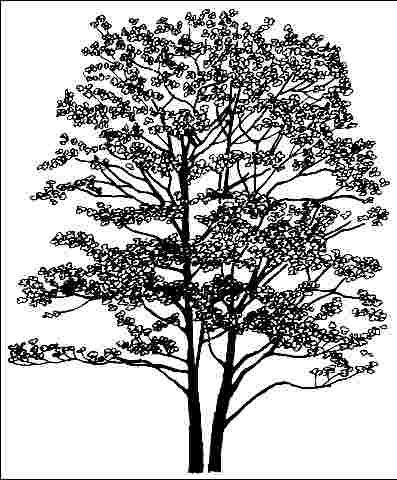
General Information
Scientific name: Cornus florida
Pronunciation: KOR-nus FLOR-ih-duh
Common name(s): 'Weavers White' flowering dogwood
Family: Cornaceae
USDA hardiness zones: 5A through 9A (Fig. 2)
Origin: native to North America
Invasive potential: little invasive potential
Uses: screen; specimen; shade; tree lawn 3–4 feet wide; tree lawn 4–6 feet wide; tree lawn > 6 ft wide; deck or patio
Availability: somewhat available, may have to go out of the region to find the tree
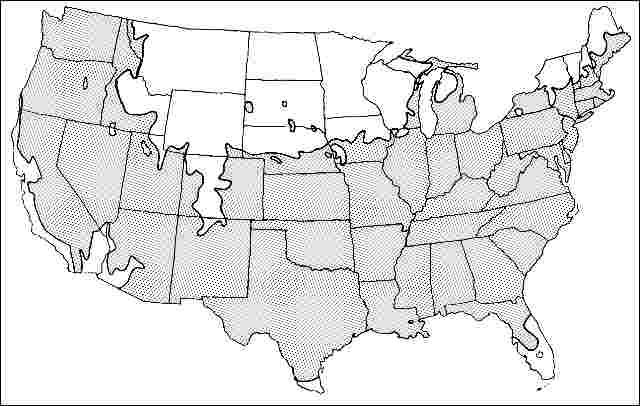
Description
Height: 20 to 30 feet
Spread: 25 to 30 feet
Crown uniformity: symmetrical
Crown shape: round
Crown density: moderate
Growth rate: moderate
Texture: medium
Foliage
Leaf arrangement: opposite/subopposite (Fig. 3)
Leaf type: simple
Leaf margin: entire
Leaf shape: ovate
Leaf venation: pinnate, bowed
Leaf type and persistence: deciduous
Leaf blade length: 2 to 4 inches, 4 to 8 inches
Leaf color: green
Fall color: red
Fall characteristic: showy
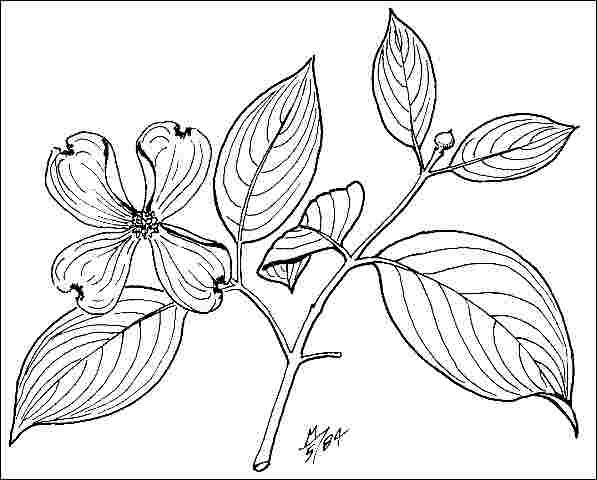
Flower
Flower color: white/cream/gray
Flower characteristics: very showy
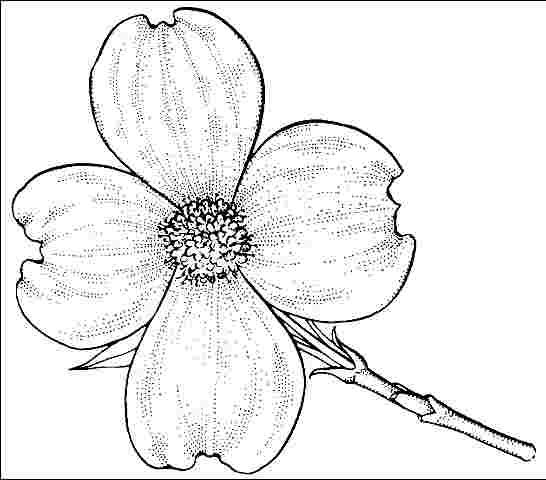
Fruit
Fruit shape: oval, round
Fruit length: less than .5 inch
Fruit covering: fleshy
Fruit color: red
Fruit characteristics: attracts birds; showy; fruit/leaves not a litter problem
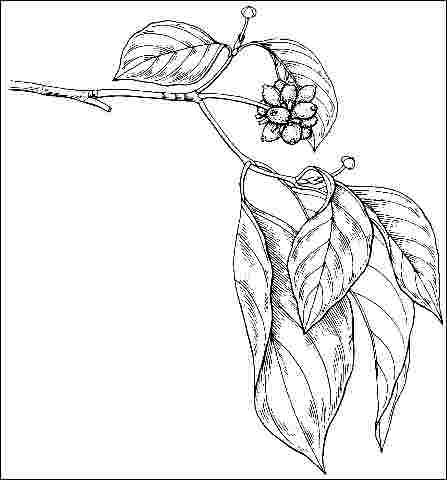
Trunk and Branches
Trunk/bark/branches: branches droop; not showy; typically multi-trunked; thorns
Pruning requirement: little required
Breakage: resistant
Current year twig color: green
Current year twig thickness: medium
Wood specific gravity: unknown
Culture
Light requirement: full sun, partial sun, or partial shade, shade tolerant
Soil tolerances: sand; loam; clay; acidic; slightly alkaline; well-drained
Drought tolerance: moderate
Aerosol salt tolerance: low
Other
Roots: not a problem
Winter interest: no
Outstanding tree: no
Ozone sensitivity: unknown
Verticillium wilt susceptibility: resistant
Pest resistance: sensitive to pests/diseases
Use and Management
The tree is not suited for parking lot planting but can be grown in a wide street median, if provided with less than full-day sun and irrigation. Dogwood is a standard tree in many gardens where it is used by the patio for light shade, in the shrub border to add spring and fall color or as a specimen in the lawn or groundcover bed. It can be grown in sun or shade but shaded trees will be less dense, grow more quickly and taller, have poor fall color, and less flowers. Trees prefer part shade (preferably in the afternoon) in the southern end of its range. Many nurseries grow the trees in full sun, but they are irrigated regularly. Flowering dogwood prefers a deep, rich, well-drained, sandy or clay soil and has a moderately long life. It is not recommended in the New Orleans area and other heavy, wet soils unless it is grown on a raised bed to keep roots on the dry side. The roots will rot in soils without adequate drainage.
Several of the cultivars listed are not readily available: Pink-flowering cultivars grow poorly in USDA hardiness zones 8 and 9. 'Apple Blossom'—pink bracts; 'Cherokee Chief'—red bracts; 'Cherokee Princess'—white bracts; 'Cloud 9' - white bracts, many blooms, flowers at early age; 'Fastigiata'—upright growth while young, spreading with age; 'First Lady'—leaves variegated with yellow turning red and maroon in the fall; 'Gigantea'—bracts 6-inches from tip of one bract to tip of opposite bract; 'Magnifica'—bracts rounded, 4-inch diameter pairs of bracts; 'Multibracteata'—double flowers; 'New Hampshire'—flower buds cold hardy; 'Pendula'—weeping or drooping branches; 'Plena'—double flowers; var. rubra—pink bracts; 'Spring Song'—bracts rose red; 'Springtime'—bracts white, large, blooms at an early age; 'Sunset'—supposedly resistant to anthracnose; 'Sweetwater Red'—bracts red; 'Welchii'—leaves variegated with yellow and red; 'White Cloud'—flowers more numerous, bracts white; 'Xanthocarpa'—fruit yellow.
Pests
Aphids may be controlled by spraying them with a strong stream of water from the garden hose.
Several borers will attack dogwood. Try to keep the trees healthy with regular fertilization, and irrigation during dry weather. Indications of borer problems are holes in the trunk, leaves smaller than normal, and dieback of the crown.
Dogwood club gall midge causes galls at the branch tips. The leaves on affected branch tips may be distorted and the branch may fail to form a flower bud. Prune out the galls as soon as they are seen.
Leaf miners cause brown blister-like mines on the undersides of leaves. The adult leaf miner skeletonizes the leaves.
Scales can build up to large numbers before being detected. Horticultural oil will help control overwintering stages.
Twig girdlers prune the tips of small branches. They are more of an annoyance than a serious problem unless you are a nursery operator.
Diseases
Dogwood anthracnose may be the biggest concern with growing flowering dogwood. Infection is favored by cool, wet spring or fall weather. Drought and stressed trees appear to be most affected, as are those at higher elevations. Trees on the coastal plain may be much less likely to become affected. Consecutive years of infection can kill trees. Keep the tree healthy with regular irrigation in dry weather but avoid overhead irrigation. Plant the tree in an area which allows the leaves to stay as dry as possible. Consult a local pathologist for the latest in control measures. Cornus kousa is thought to be resistant to anthracnose and it can be planted in areas where anthracnose is a problem. It is a very beautiful tree.
Early symptoms of dogwood canker are smaller and paler leaves than normal. Leaves on infected branches are red earlier in the fall. At first the symptoms appear only on the infected side of the tree but become more general as the canker enlarges. There is no chemical control for the disease. Avoid trunk wounds during and after planting.
Crown canker is associated with wet soils and can be controlled with appropriate fungicides.
Flower and leaf blight attacks fading bracts, especially during wet weather. Infected flower parts fall on the leaves spreading the infection.
A large number of leaf spots attack dogwood. Clean up and dispose of infected leaves.
Powdery mildew covers the leaves with a fine white coating.
Leaf scorch occurs during hot, dry, windy weather. This condition looks like a disease. Scorch symptoms are drying and browning of the leaf margins, or, in more serious cases, drying and browning of the interveinal area.